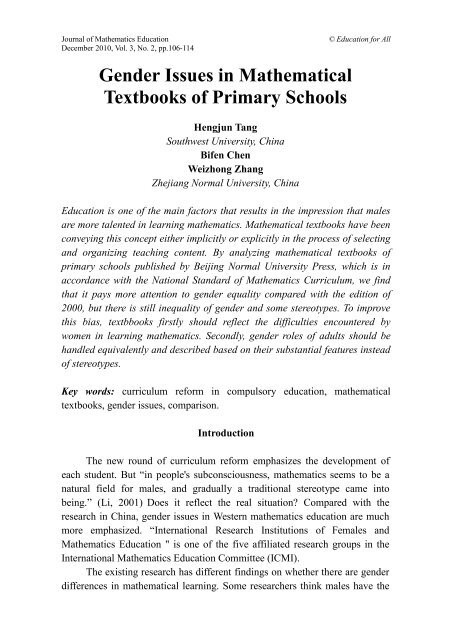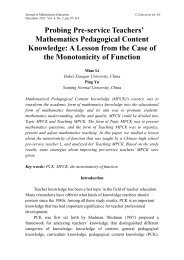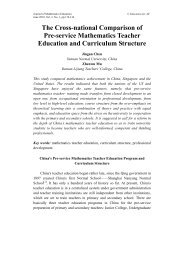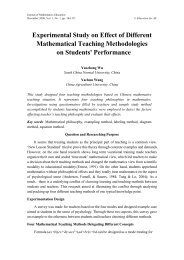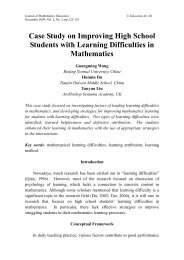Gender Issues in Mathematical Textbooks of Primary Schools
Gender Issues in Mathematical Textbooks of Primary Schools
Gender Issues in Mathematical Textbooks of Primary Schools
Create successful ePaper yourself
Turn your PDF publications into a flip-book with our unique Google optimized e-Paper software.
Journal <strong>of</strong> Mathematics Education<br />
December 2010, Vol. 3, No. 2, pp.106-114<br />
© Education for All<br />
<strong>Gender</strong> <strong>Issues</strong> <strong>in</strong> <strong>Mathematical</strong><br />
<strong>Textbooks</strong> <strong>of</strong> <strong>Primary</strong> <strong>Schools</strong><br />
Hengjun Tang<br />
Southwest University, Ch<strong>in</strong>a<br />
Bifen Chen<br />
Weizhong Zhang<br />
Zhejiang Normal University, Ch<strong>in</strong>a<br />
Education is one <strong>of</strong> the ma<strong>in</strong> factors that results <strong>in</strong> the impression that males<br />
are more talented <strong>in</strong> learn<strong>in</strong>g mathematics. <strong>Mathematical</strong> textbooks have been<br />
convey<strong>in</strong>g this concept either implicitly or explicitly <strong>in</strong> the process <strong>of</strong> select<strong>in</strong>g<br />
and organiz<strong>in</strong>g teach<strong>in</strong>g content. By analyz<strong>in</strong>g mathematical textbooks <strong>of</strong><br />
primary schools published by Beij<strong>in</strong>g Normal University Press, which is <strong>in</strong><br />
accordance with the National Standard <strong>of</strong> Mathematics Curriculum, we f<strong>in</strong>d<br />
that it pays more attention to gender equality compared with the edition <strong>of</strong><br />
2000, but there is still <strong>in</strong>equality <strong>of</strong> gender and some stereotypes. To improve<br />
this bias, textbbooks firstly should reflect the difficulties encountered by<br />
women <strong>in</strong> learn<strong>in</strong>g mathematics. Secondly, gender roles <strong>of</strong> adults should be<br />
handled equivalently and described based on their substantial features <strong>in</strong>stead<br />
<strong>of</strong> stereotypes.<br />
Key words: curriculum reform <strong>in</strong> compulsory education, mathematical<br />
textbooks, gender issues, comparison.<br />
Introduction<br />
The new round <strong>of</strong> curriculum reform emphasizes the development <strong>of</strong><br />
each student. But “<strong>in</strong> people's subconsciousness, mathematics seems to be a<br />
natural field for males, and gradually a traditional stereotype came <strong>in</strong>to<br />
be<strong>in</strong>g.” (Li, 2001) Does it reflect the real situation? Compared with the<br />
research <strong>in</strong> Ch<strong>in</strong>a, gender issues <strong>in</strong> Western mathematics education are much<br />
more emphasized. “International Research Institutions <strong>of</strong> Females and<br />
Mathematics Education " is one <strong>of</strong> the five affiliated research groups <strong>in</strong> the<br />
International Mathematics Education Committee (ICMI).<br />
The exist<strong>in</strong>g research has different f<strong>in</strong>d<strong>in</strong>gs on whether there are gender<br />
differences <strong>in</strong> mathematical learn<strong>in</strong>g. Some researchers th<strong>in</strong>k males have the
Hengjun Tang, Bifen Chen, & Weizhong Zhang 107<br />
superiority <strong>in</strong> mathematics learn<strong>in</strong>g (Maeeoby & Carol, 1974; Brandell, Leder,<br />
& Nystrom, 2007); others believe that males and females have their respective<br />
advantages (Benbow, 1992; Hyde, Fennema, & Lamonj, 1990). Nevertheless,<br />
the apparent consensus is that gender is an important factor <strong>in</strong> mathematics<br />
learn<strong>in</strong>g (Zhang, 2006). However, the causes <strong>of</strong> gender differences also fall<br />
<strong>in</strong>to two camps. Some researchers believe that gender differences <strong>in</strong><br />
mathematics can be ma<strong>in</strong>ly attributed to physical, mental and other factors<br />
(Kimball, 1989; Geary, Sauzts, & Liu, 2000); others suggest that external<br />
factors like social and cultural factors are dom<strong>in</strong>ant causes <strong>of</strong> the gender<br />
differences (Fan & Li,,2008). ICMI (1992) proposed a basic conclusion:<br />
Women have no obstacles <strong>in</strong> participat<strong>in</strong>g <strong>in</strong> mathematics <strong>in</strong> physical and<br />
mental aspects (Li, 2001). That is, the gender differences <strong>in</strong> mathematics<br />
learn<strong>in</strong>g are ma<strong>in</strong>ly caused by social and cultural factors, particularly school<br />
education which plays an important role <strong>in</strong> children’s gender socialization.<br />
In the view <strong>of</strong> the <strong>in</strong>ternal elements <strong>of</strong> mathematics education,<br />
mathematical knowledge learn<strong>in</strong>g is one <strong>of</strong> the ma<strong>in</strong> tasks <strong>of</strong> mathematics<br />
education. <strong>Mathematical</strong> knowledge is <strong>of</strong>ten considered to be culture free and<br />
pure rational knowledge, and traditional mathematics education is always<br />
comply<strong>in</strong>g with this teach<strong>in</strong>g concept. However, the sociology <strong>of</strong> knowledge<br />
posits that, "knowledge, <strong>in</strong>clud<strong>in</strong>g subject knowledge, is 'not only knowledge,<br />
but also a social practice'. It is the ref<strong>in</strong>ed cultural and symbolic system that is<br />
selectively constructed by people which '<strong>in</strong>cludes the theoretical premise and<br />
ideology beneficial to these <strong>in</strong> charge (Shi, 2004). Much research on<br />
ethnomathematics and multicultural mathematics supports this view. That is,<br />
mathematics textbooks <strong>in</strong>evitably attach and deliver a specific gender<br />
perception <strong>in</strong> select<strong>in</strong>g and organiz<strong>in</strong>g mathematical knowledge either<br />
implicitly or explicitly. Based on the above understand<strong>in</strong>g, we th<strong>in</strong>k it is very<br />
important to analyze the gender concepts <strong>in</strong> mathematical textbooks.<br />
Methods<br />
We compared "<strong>Primary</strong> School Mathematics Textbook Based on<br />
Curriculum Standard" (MTCS), which was published by the Beij<strong>in</strong>g Normal<br />
University (BNU) with "Mathematics Textbook Based on Syllabus" (MTS),<br />
which was published by the Beij<strong>in</strong>g Normal University <strong>in</strong> 2000. We want to<br />
reflect the perfection course <strong>of</strong> gender equality <strong>in</strong> textbooks, also further<br />
reveal the gender equality problems <strong>in</strong> MTCS. It should be expla<strong>in</strong>ed that the<br />
selection <strong>of</strong> the textbooks published by BNU does not mean that only this
108 <strong>Gender</strong> <strong>Issues</strong> <strong>in</strong> <strong>Mathematical</strong> <strong>Textbooks</strong><br />
version has related problems, but that the editions are one <strong>of</strong> the typical<br />
materials <strong>of</strong> the new curriculum, and have a certa<strong>in</strong> <strong>in</strong>fluence. In the specific<br />
analysis, we selected four textbooks from MTCS by <strong>in</strong>terval sampl<strong>in</strong>g: the<br />
f<strong>in</strong>al volume <strong>of</strong> the first grade (2005), the first volume <strong>of</strong> the third grade<br />
(2006), the f<strong>in</strong>al volume <strong>of</strong> the fourth grade (2005), and the first volume <strong>of</strong> the<br />
sixth grade (2006).<br />
We analyzed gender from the frequency and activities <strong>of</strong> characters<br />
which appeared <strong>in</strong> the textbook illustrations and the role <strong>of</strong> adults. There are<br />
<strong>of</strong>ten more than one character <strong>in</strong> an illustration. At this time, we used<br />
<strong>in</strong>dividuals as a statistical analysis unit. However, when characters <strong>in</strong> an<br />
illustration have equal status, then they are counted as one, such as the<br />
illustration <strong>of</strong> "long jump" on page 15 <strong>in</strong> the fourth grade MTCS, the boys or<br />
girls are only counted as one person. In addition, as activities appear <strong>in</strong> the<br />
form <strong>of</strong> illustrations, we analyze activities based on the gender roles <strong>of</strong> the<br />
characters, which we divide <strong>in</strong>to “the pure male”, “the pure female”, and “the<br />
mixed type”. “The mixed type” is aga<strong>in</strong> divided <strong>in</strong>to three categories<br />
accord<strong>in</strong>g to the ma<strong>in</strong> characters, namely “no gender difference”, “male<br />
dom<strong>in</strong>ant” and “female dom<strong>in</strong>ant”. It needs to be expla<strong>in</strong>ed that, "no gender<br />
differences" is concluded when “the mixed type” ma<strong>in</strong>ly results from different<br />
age groups. For example, <strong>in</strong> the illustration <strong>of</strong> “Female teachers guide students<br />
to take a bus” on page 7 <strong>in</strong> the third grade <strong>of</strong> MTCS, although female teachers<br />
is the leader, it is still classified as "no gender difference”.<br />
Status <strong>of</strong> <strong>Gender</strong> <strong>Issues</strong> <strong>in</strong> <strong>Primary</strong> School <strong>Mathematical</strong> <strong>Textbooks</strong><br />
A High Frequency <strong>of</strong> Male Appearance <strong>in</strong> the <strong>Textbooks</strong><br />
There are 931 people <strong>in</strong> the four volumes <strong>of</strong> MTCS, among them 515<br />
people are male, which accounts for 55.3% (Table 1). The frequency <strong>of</strong> the<br />
2<br />
male appearance is obviously higher than that <strong>of</strong> female ( x =10.53, p 0.05), which <strong>in</strong>dicates that the phenomenon <strong>of</strong> “male more<br />
than female” are <strong>in</strong> conformity with various volumes <strong>of</strong> the textbooks, and<br />
becomes more remarkable along with the higher grade. But compared with the<br />
data from MTS (Shi,, 2004), MTCS had dist<strong>in</strong>ct improvement.<br />
Table 1
the f<strong>in</strong>al<br />
volume<br />
<strong>of</strong> the<br />
first<br />
grade<br />
the first<br />
volume<br />
<strong>of</strong> the<br />
third<br />
grade<br />
the f<strong>in</strong>al<br />
volume<br />
<strong>of</strong> the<br />
fourth<br />
grade<br />
the first<br />
volume<br />
<strong>of</strong> the<br />
sixth<br />
grade<br />
the f<strong>in</strong>al<br />
volume <strong>of</strong><br />
the first<br />
grade<br />
the first<br />
volume <strong>of</strong><br />
the third<br />
grade<br />
the f<strong>in</strong>al<br />
volume <strong>of</strong><br />
the fourth<br />
grade<br />
the first<br />
volume <strong>of</strong><br />
the sixth<br />
grade<br />
Hengjun Tang, Bifen Chen, & Weizhong Zhang 109<br />
The Frequency <strong>of</strong> Male Appearance and Female <strong>in</strong> MTCS<br />
Sum<br />
2<br />
x<br />
P<br />
Male<br />
144 132 123 116 515<br />
(52.9%) (54.3%) (56.4%) (58.6%) (55.3%)<br />
Female<br />
128 111 95 82 416<br />
(47.1%) (45.7%) (43.6%) (41.4%) (44.7%)<br />
Sum 272 243 218 198 931<br />
10.53 P
110 <strong>Gender</strong> <strong>Issues</strong> <strong>in</strong> <strong>Mathematical</strong> <strong>Textbooks</strong><br />
type female dom<strong>in</strong>ant 16 6 8 5 35<br />
The Existence <strong>of</strong> Adult <strong>Gender</strong> Role Stereotypes<br />
The most direct <strong>in</strong>fluences on the socialization <strong>of</strong> children’s gender roles<br />
are the grown-ups’ family roles and the pr<strong>of</strong>essional roles. From the analysis<br />
<strong>of</strong> the MTCS, we found that the gender role stereotypes <strong>of</strong> adult males and<br />
females still exist. First, the males and females’ traditional family roles have<br />
not been broken through, which are specifically demonstrated <strong>in</strong> the activities<br />
<strong>of</strong> "father", "mother" and other family members engaged <strong>in</strong>. In the illustrations<br />
which appear <strong>in</strong> the form <strong>of</strong> family (besides the illustrations us<strong>in</strong>g “height”,<br />
“age” and other data as question backgrounds), the mascul<strong>in</strong>e family roles<br />
ma<strong>in</strong>ly appear <strong>in</strong> travel<strong>in</strong>g (2) (the digit <strong>in</strong> parenthesis presents number <strong>of</strong><br />
people), divid<strong>in</strong>g the <strong>in</strong>heritance (1), mak<strong>in</strong>g dumpl<strong>in</strong>gs (1), and shopp<strong>in</strong>g (1);<br />
However, the fem<strong>in</strong><strong>in</strong>e family roles ma<strong>in</strong>ly appears <strong>in</strong> shopp<strong>in</strong>g (3), feed<strong>in</strong>g<br />
chickens (2), travel<strong>in</strong>g (2), accompany<strong>in</strong>g child at home (1), and mak<strong>in</strong>g<br />
dumpl<strong>in</strong>gs (1). Obviously, the frequency <strong>of</strong> male appearance <strong>in</strong> the<br />
illustrations is less than that <strong>of</strong> the female. Moreover, the fem<strong>in</strong><strong>in</strong>e actions<br />
such as shopp<strong>in</strong>g, accompany<strong>in</strong>g child at home are consistent with the<br />
traditional concepts.<br />
Next, the distribution range <strong>of</strong> mascul<strong>in</strong>e social roles is broad. The<br />
statistics show that <strong>in</strong> MTCS, from most to least, the mascul<strong>in</strong>e social role <strong>in</strong><br />
turn is sapiential old men (41), mathematicians (5), sales clerks (5), country<br />
leaders (4), personnel related to sports (4), drivers (3), scientists (2), teachers<br />
(3), farmers (3), ancient celebrities (2), chefs (2), workers (2), ord<strong>in</strong>ary<br />
citizens (2), astronauts (1) and bank staff (1). However, from most to least, the<br />
fem<strong>in</strong><strong>in</strong>e social role is teachers (22), sales clerks (15), personnel related to<br />
sports (6), ticket sellers (3), television hosts (3), on-stage hotel servants (1),<br />
librarians (1), technical personnel (1) and ord<strong>in</strong>ary citizens (1).<br />
So, the mascul<strong>in</strong>e role displays more <strong>in</strong>tellectual and technical tendency.<br />
For <strong>in</strong>stance, there are mathematicians and scientists who create knowledge<br />
directly, and also sapiential persons and so on. There are also drivers, chefs<br />
and so on whose positions need pr<strong>of</strong>essional skills. The fem<strong>in</strong><strong>in</strong>e roles,<br />
however display more <strong>of</strong> a service tendency. If we take sales clerks, ticket<br />
sellers, on-stage servants <strong>of</strong> hotels and librarians as service personnel, then the<br />
service personnel <strong>of</strong> female amounts to 20 people, occupy<strong>in</strong>g 38.5% <strong>of</strong> the<br />
fem<strong>in</strong><strong>in</strong>e roles, but the correspond<strong>in</strong>g data <strong>of</strong> males is only 6.3%.<br />
Suggestions to Promote <strong>Gender</strong> Equality <strong>in</strong> <strong>Mathematical</strong> <strong>Textbooks</strong>
Hengjun Tang, Bifen Chen, & Weizhong Zhang 111<br />
After analyz<strong>in</strong>g the textbooks, we found that the authors <strong>of</strong><br />
mathematical textbooks have paid close attention to gender equality <strong>in</strong> Ch<strong>in</strong>a,<br />
but there are also some gender role stereotypes as a whole. For <strong>in</strong>stance,<br />
sapiential old persons, young doctors and so on who are through out the whole<br />
set <strong>of</strong> textbooks appear <strong>in</strong> mascul<strong>in</strong>e image, which conforms to the social<br />
value orientation. It maybe the reflection <strong>of</strong> the gender roles which exist<br />
generally <strong>in</strong> people’s subconsciousness and are conveyed through textbooks to<br />
the next generation. Therefore, the improvement <strong>of</strong> elementary school<br />
textbooks’ gender roles is very important. We believe that we may improve the<br />
above phenomenon through the follow<strong>in</strong>g aspects.<br />
Reflect<strong>in</strong>g the Difficulty <strong>of</strong> Females <strong>in</strong> Learn<strong>in</strong>g Mathematics<br />
The mathematicians <strong>in</strong>troduced <strong>in</strong> the elementary school mathematical<br />
textbooks are only males, which will cause the students to th<strong>in</strong>k that<br />
mathematics is created by males and females are not worthy <strong>of</strong> mention<strong>in</strong>g, as<br />
well as believ<strong>in</strong>g that females are <strong>in</strong>ferior to males <strong>in</strong> mathematical ability .<br />
Although <strong>in</strong> mathematical history female mathematicians are truly very few,<br />
education should not just tell students the fact. More importantly, we should<br />
make students understand the social reasons for fewer female mathematicians.<br />
In history, females suffered more resistance <strong>in</strong> study<strong>in</strong>g and research<strong>in</strong>g<br />
mathematics than males. Hypatia (370-415), the first female mathematician <strong>in</strong><br />
the world, was ripped by frantic Christians. In ancient times, females are<br />
framed more as “the good wife and lov<strong>in</strong>g mother”, and <strong>in</strong> ancient Ch<strong>in</strong>a,<br />
people believed that “female <strong>in</strong>capacity is virtue”. Fem<strong>in</strong><strong>in</strong>e mathematical<br />
talent was neglected by the feudal values that “Females are <strong>in</strong>ferior to males”.<br />
Therefore, females were denied the access to learn<strong>in</strong>g mathematics. We learn<br />
from the related documents that the history <strong>of</strong> allow<strong>in</strong>g females to enter higher<br />
<strong>in</strong>stitutions to study mathematics is only 130 years old. This reality caused<br />
females to lose the opportunity to study<strong>in</strong>g advanced mathematics, which then<br />
created gender differences <strong>in</strong> mathematics (L<strong>in</strong>g,S.,2006) that we see today.<br />
Therefore, textbooks should not only <strong>in</strong>crease the content <strong>of</strong> the fem<strong>in</strong><strong>in</strong>e<br />
mathematicians’ contribution directly, but also <strong>in</strong>troduce particular difficulties<br />
<strong>of</strong> females dur<strong>in</strong>g study<strong>in</strong>g and research<strong>in</strong>g mathematics <strong>in</strong> history.<br />
Balanced Treatment <strong>of</strong> Adult <strong>Gender</strong> Roles <strong>in</strong> <strong>Textbooks</strong><br />
<strong>Gender</strong> roles are a social cultural production, and are extended by<br />
longitud<strong>in</strong>al dissem<strong>in</strong>ation <strong>in</strong> identical cultures. Namely, <strong>in</strong> a macroscopic<br />
view, the formation <strong>of</strong> the gender role idea is a circulation from the <strong>in</strong>dividual
112 <strong>Gender</strong> <strong>Issues</strong> <strong>in</strong> <strong>Mathematical</strong> <strong>Textbooks</strong><br />
cultural unconsciousness to the collective cultural unconsciousness and then<br />
the <strong>in</strong>dividual cultural unconsciousness aga<strong>in</strong>. Through such cyclic processes,<br />
people are used to the phenomenon <strong>of</strong> “men and women are materially not<br />
equal” (for <strong>in</strong>stance very few people ponder “why <strong>in</strong> our impression sapiential<br />
old people are always male”). In a microcosmic view, students firstly feel the<br />
gender division <strong>of</strong> the adult world from their life, and by imitat<strong>in</strong>g their<br />
parents and other adults’ behavioral patterns they obta<strong>in</strong> approvals; then such<br />
experience is strengthened <strong>in</strong> schools through teacher's behaviors, the<br />
textbooks’ implications and f<strong>in</strong>ally students form the gender roles <strong>in</strong> a specific<br />
culture. Therefore, textbooks should arrange adults’ gender roles <strong>in</strong> balance<br />
and consciously. In fact, along with many endeavors which work on the<br />
equality <strong>of</strong> the genders <strong>in</strong> Ch<strong>in</strong>a, numerous talented females emerge <strong>in</strong> various<br />
trades and occupations. Even <strong>in</strong> the mathematical doma<strong>in</strong>, there are also<br />
renowned female mathematicians like Yangzhi Gao, Ruiyun Xu and Hesheng<br />
Hu and so on.<br />
Chang<strong>in</strong>g Character Roles from Stereotypes to Substantial Roles<br />
Examples are an important medium <strong>in</strong> study. The children’s roles which<br />
are similar to the students do more than just make abstract bor<strong>in</strong>g mathematics<br />
familiar. Moreover, these roles may also show the process <strong>of</strong> learn<strong>in</strong>g<br />
mathematics. MTCS presents many children’s roles and sets two student roles<br />
named “mischievous” (male) and smil<strong>in</strong>g (female) thoughout the whole<br />
textbook. Unfortunately, the two names “mischievous” and “smil<strong>in</strong>g” have the<br />
mechanical gender impression. More importantly, readers cannot f<strong>in</strong>d their<br />
substantive, cont<strong>in</strong>uous mathematics activities <strong>in</strong> the textbook, and also their<br />
special thought characteristics are not manifested. Two aspects <strong>of</strong> endeavors<br />
are <strong>in</strong> need if we want examples <strong>in</strong> textbooks to have essential functions. First,<br />
from the longitud<strong>in</strong>al aspect, character roles need to have the respective<br />
mathematical characteristics, and ma<strong>in</strong>ta<strong>in</strong> their thought characteristics<br />
consistently. For <strong>in</strong>stance, some students are accustomed to study<strong>in</strong>g<br />
mathematics by comput<strong>in</strong>g and <strong>in</strong>ferenc<strong>in</strong>g while other students are used to<br />
study<strong>in</strong>g mathematics by operat<strong>in</strong>g <strong>in</strong>tuitively. Therefore, textbooks may also<br />
hypothesize two k<strong>in</strong>ds <strong>of</strong> character roles <strong>of</strong> these different study methods. Of<br />
course we should avoid conscious gender differentiation <strong>in</strong> different learn<strong>in</strong>g<br />
methods <strong>in</strong> this process. For example, we must avoid assum<strong>in</strong>g that female<br />
students fit <strong>in</strong>to operat<strong>in</strong>g <strong>in</strong>tuitively, while male students favor comput<strong>in</strong>g<br />
and <strong>in</strong>ferenc<strong>in</strong>g. Besides, from the horizontal perspective, we must give<br />
students the opportunities to experience different functions <strong>of</strong> various methods
Hengjun Tang, Bifen Chen, & Weizhong Zhang 113<br />
<strong>in</strong> solv<strong>in</strong>g identical problems. Meanwhile, we must unfold the situation that<br />
students learn from other students to make up their own <strong>in</strong>sufficiency.<br />
In brief, the gender equality is one <strong>of</strong> the important aspects <strong>of</strong><br />
educational fairness, and education is the primary factor <strong>in</strong> form<strong>in</strong>g children’s<br />
gender roles. Therefore, we need to cultivate an educational environment for<br />
students which convey gender equality. The most important th<strong>in</strong>g is that<br />
mathematics teachers and textbook editors should pay attention and reflect<br />
gender issues <strong>in</strong> the current textbooks.<br />
References<br />
Benbow, C. P. (1992). Academic achievement <strong>in</strong> mathematics and science <strong>of</strong><br />
students between ages 13 and 23: Are there differences among students <strong>in</strong><br />
the top one percent <strong>of</strong> mathematical ability? Journal <strong>of</strong> Educational<br />
Psychology, 84(l), 51-61.<br />
Fan, W., & Li, W. (2008). Commentary on researches <strong>of</strong> gender differences <strong>of</strong><br />
mathematics study <strong>in</strong> western. Comparative Education Review, 9, 77-82.<br />
Geary, D.C., Sauzts, S.J., & Liu, F. (2000). Sex difference <strong>in</strong> spatial cognition,<br />
computational flueney, and arithmetical reason<strong>in</strong>g. Journal <strong>of</strong><br />
Experimental Child Psychology, 77, 337-353.<br />
Brandell, G., Leder, G. & Nystrom, P. (2007). <strong>Gender</strong> and mathematics :<br />
Recent development from a Swedish perspective. ZDM, 39, 235-250.<br />
Hyde, J. S., Fennema, E., & Lamonj, S. J. (1990). <strong>Gender</strong> differences <strong>in</strong><br />
mathematics performance. Psychological Bullet<strong>in</strong>, 107, 299-324.<br />
Kimball, M. M. (1989). A new perspective on women’s math achievement.<br />
Psychological Bullet<strong>in</strong>, 104, 53-69<br />
Li, S. (2001). Psychology <strong>of</strong> mathematics education (pp.237, 232). Shanghai:<br />
East Ch<strong>in</strong>a Normal University Press,<br />
L<strong>in</strong>g, S. (2006). Reason analysis <strong>of</strong> the gender differences <strong>in</strong> mathematics.<br />
Social Sciences <strong>of</strong> Guangxi, 8, 164-167.<br />
Maeeoby, E., & Carol, J. (1974).Psychology <strong>of</strong> sex differences. Stanford, CA:<br />
University Press.<br />
Shi,, J. (2004). Enter<strong>in</strong>g gender world <strong>of</strong> the textbooks and teach<strong>in</strong>g. Beij<strong>in</strong>g,<br />
Science <strong>of</strong> education Press, 11, 290.<br />
Zhang, X.(2006). Commentary on researches <strong>of</strong> gender differences <strong>of</strong> middle<br />
school students’ mathematical skill. Journal <strong>of</strong> Tanj<strong>in</strong> Normal University<br />
(Basic education edition), 7(2), 44-47.
114 <strong>Gender</strong> <strong>Issues</strong> <strong>in</strong> <strong>Mathematical</strong> <strong>Textbooks</strong><br />
Authors:<br />
Hengjun Tang<br />
Research Center <strong>of</strong> Basic Education, Southwest University, Ch<strong>in</strong>a<br />
Email:thjnb@swu.edu.cn<br />
Bifen Chen<br />
College <strong>of</strong> Education, Zhejiang Normal University, Ch<strong>in</strong>a<br />
Email:80bee@zjnu.cn<br />
Weizhong Zhang<br />
College <strong>of</strong> Education, Zhejiang Normal University, Ch<strong>in</strong>a<br />
Email:lzzwz@zjnu.cn


